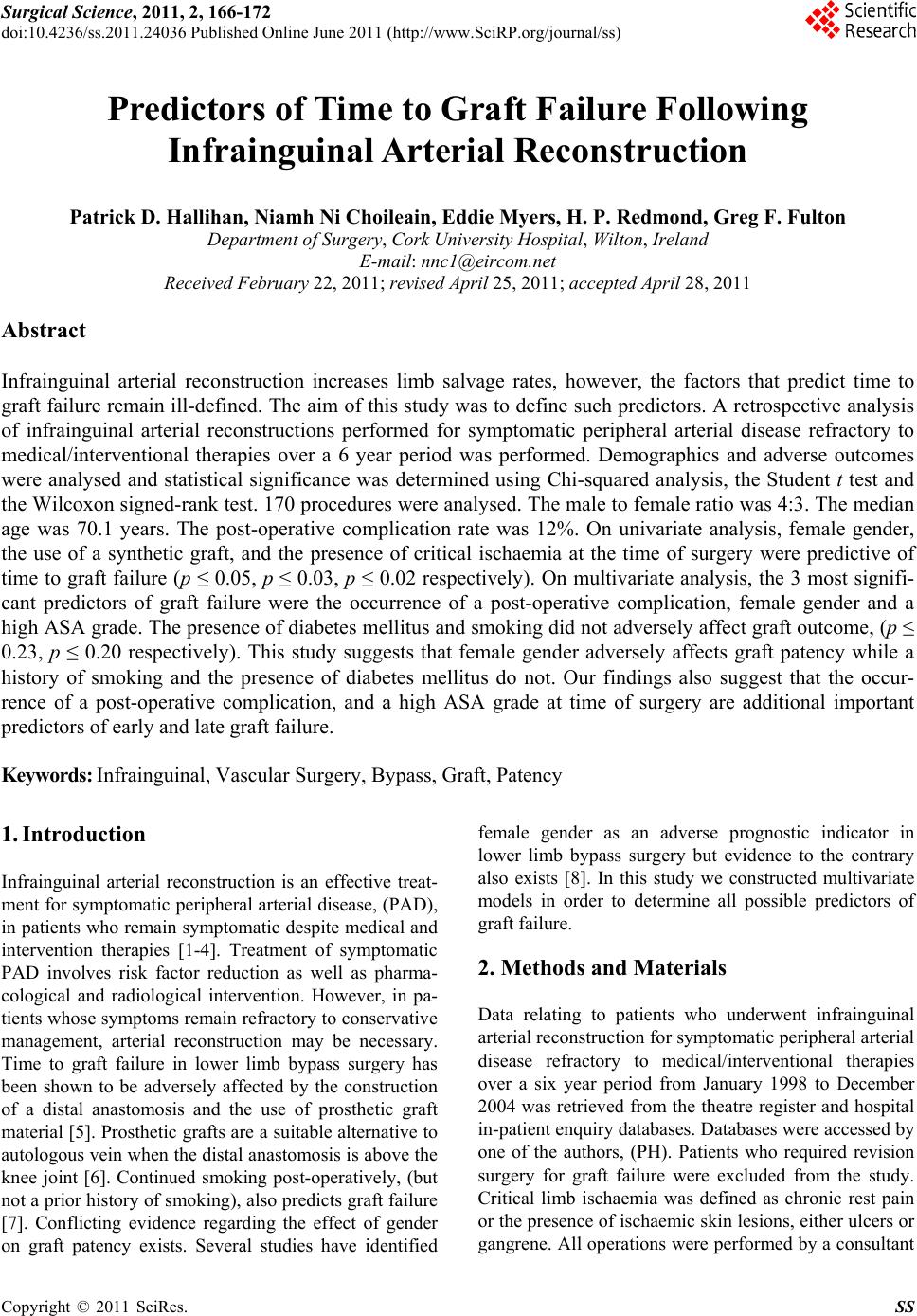 Surgical Science, 2011, 2, 166-172 doi:10.4236/ss.2011.24036 Published Online June 2011 (http://www.SciRP.org/journal/ss) Copyright © 2011 SciRes. SS Predictors of Time to Graft Failure Following Infrainguinal Arterial Reconstruction Patrick D. Hallihan, Niamh Ni Choileain, Eddie Myers, H. P. Redmond, Greg F. Fulton Department of Surgery, Cork University Hospital, Wilton, Ireland E-mail: nnc1@eircom.net Received February 22, 2011; revised April 25, 2011; accepted April 28, 2011 Abstract Infrainguinal arterial reconstruction increases limb salvage rates, however, the factors that predict time to graft failure remain ill-defined. The aim of this study was to define such predictors. A retrospective analysis of infrainguinal arterial reconstructions performed for symptomatic peripheral arterial disease refractory to medical/interventional therapies over a 6 year period was performed. Demographics and adverse outcomes were analysed and statistical significance was determined using Chi-squared analysis, the Student t test and the Wilcoxon signed-rank test. 170 procedures were analysed. The male to female ratio was 4:3. The median age was 70.1 years. The post-operative complication rate was 12%. On univariate analysis, female gender, the use of a synthetic graft, and the presence of critical ischaemia at the time of surgery were predictive of time to graft failure (p ≤ 0.05, p ≤ 0.03, p ≤ 0.02 respectively). On multivariate analysis, the 3 most signifi- cant predictors of graft failure were the occurrence of a post-operative complication, female gender and a high ASA grade. The presence of diabetes mellitus and smoking did not adversely affect graft outcome, (p ≤ 0.23, p ≤ 0.20 respectively). This study suggests that female gender adversely affects graft patency while a history of smoking and the presence of diabetes mellitus do not. Our findings also suggest that the occur- rence of a post-operative complication, and a high ASA grade at time of surgery are additional important predictors of early and late graft failure. Keywords: Infrainguinal, Vascular Surgery, Bypass, Graft, Patency 1. Introduction Infrainguinal arterial reconstruction is an effective treat- ment for symptomatic peripheral arterial disease, (PAD), in patients who remain symptomatic despite medical and intervention therapies [1-4]. Treatment of symptomatic PAD involves risk factor reduction as well as pharma- cological and radiological intervention. However, in pa- tients whose symptoms remain refractory to conservative management, arterial reconstruction may be necessary. Time to graft failure in lower limb bypass surgery has been shown to be adversely affected by the construction of a distal anastomosis and the use of prosthetic graft material [5]. Prosthetic grafts are a suitable alternative to autologous vein when the distal anastomosis is above the knee joint [6]. Continued smoking post-operatively, (but not a prior history of smoking), also predicts graft failure [7]. Conflicting evidence regarding the effect of gender on graft patency exists. Several studies have identified female gender as an adverse prognostic indicator in lower limb bypass surgery but evidence to the contrary also exists [8]. In this study we constructed multivariate models in order to determine all possible predictors of graft failure. 2. Methods and Materials Data relating to patients who underwent infrainguinal arterial reconstruction for symptomatic peripheral arterial disease refractory to medical/interventional therapies over a six year period from January 1998 to December 2004 was retrieved from the theatre register and hospital in-patient enquiry databases. Databases were accessed by one of the authors, (PH). Patients who required revision surgery for graft failure were excluded from the study. Critical limb ischaemia was defined as chronic rest pain or the presence of ischaemic skin lesions, either ulcers or gangrene. All operations were performed by a consultant 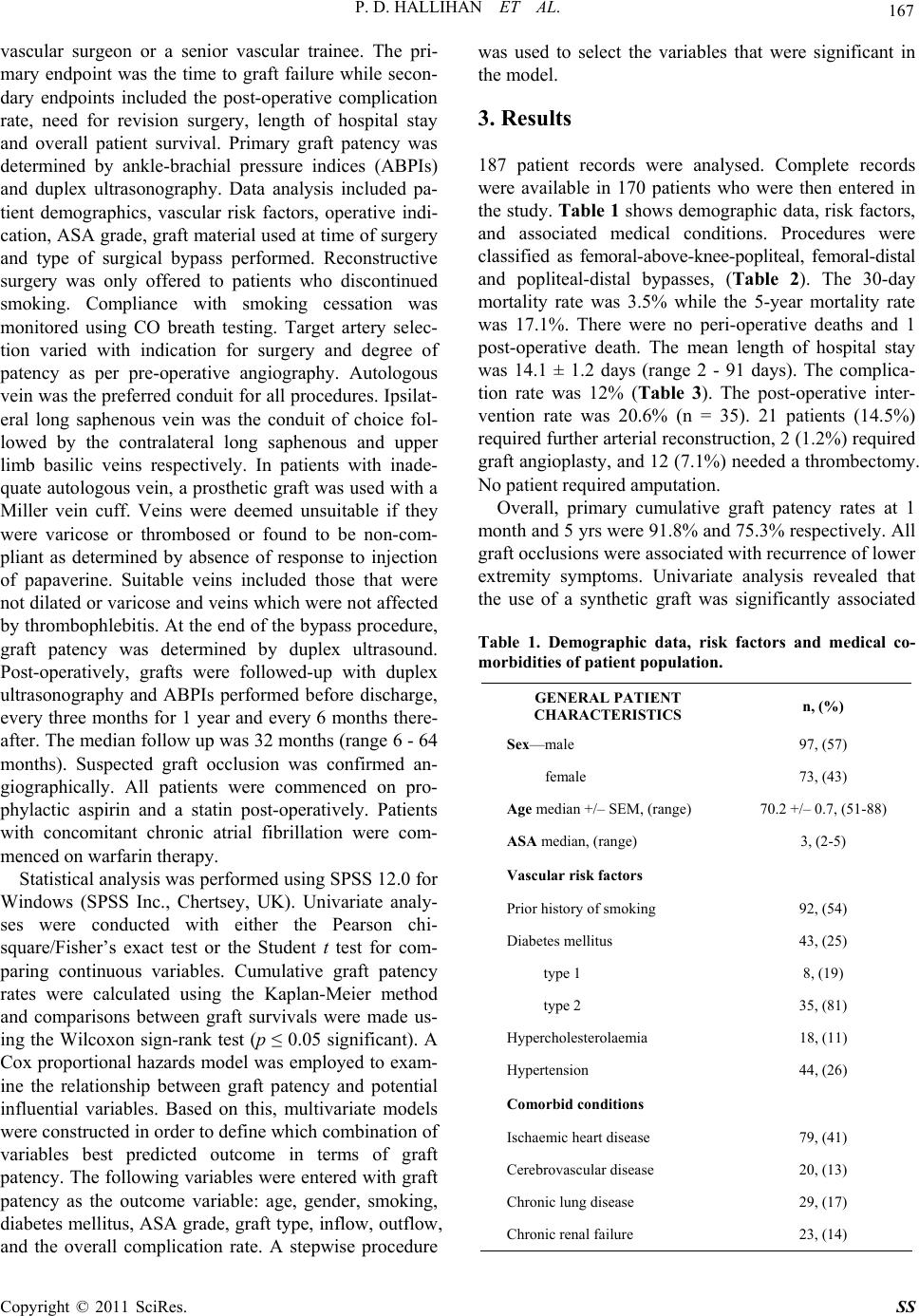 P. D. HALLIHAN ET AL. 167 vascular surgeon or a senior vascular trainee. The pri- mary endpoint was the time to graft failure while secon- dary endpoints included the post-operative complication rate, need for revision surgery, length of hospital stay and overall patient survival. Primary graft patency was determined by ankle-brachial pressure indices (ABPIs) and duplex ultrasonography. Data analysis included pa- tient demographics, vascular risk factors, operative indi- cation, ASA grade, graft material used at time of surgery and type of surgical bypass performed. Reconstructive surgery was only offered to patients who discontinued smoking. Compliance with smoking cessation was monitored using CO breath testing. Target artery selec- tion varied with indication for surgery and degree of patency as per pre-operative angiography. Autologous vein was the preferred conduit for all procedures. Ipsilat- eral long saphenous vein was the conduit of choice fol- lowed by the contralateral long saphenous and upper limb basilic veins respectively. In patients with inade- quate autologous vein, a prosthetic graft was used with a Miller vein cuff. Veins were deemed unsuitable if they were varicose or thrombosed or found to be non-com- pliant as determined by absence of response to injection of papaverine. Suitable veins included those that were not dilated or varicose and veins which were not affected by thrombophlebitis. At the end of the bypass procedure, graft patency was determined by duplex ultrasound. Post-operatively, grafts were followed-up with duplex ultrasonography and ABPIs performed before discharge, every three months for 1 year and every 6 months there- after. The median follow up was 32 months (range 6 - 64 months). Suspected graft occlusion was confirmed an- giographically. All patients were commenced on pro- phylactic aspirin and a statin post-operatively. Patients with concomitant chronic atrial fibrillation were com- menced on warfarin therapy. Statistical analysis was performed using SPSS 12.0 for Windows (SPSS Inc., Chertsey, UK). Univariate analy- ses were conducted with either the Pearson chi- square/Fisher’s exact test or the Student t test for com- paring continuous variables. Cumulative graft patency rates were calculated using the Kaplan-Meier method and comparisons between graft survivals were made us- ing the Wilcoxon sign-rank test (p ≤ 0.05 significant). A Cox proportional hazards model was employed to exam- ine the relationship between graft patency and potential influential variables. Based on this, multivariate models were constructed in order to define which combination of variables best predicted outcome in terms of graft patency. The following variables were entered with graft patency as the outcome variable: age, gender, smoking, diabetes mellitus, ASA grade, graft type, inflow, outflow, and the overall complication rate. A stepwise procedure was used to select the variables that were significant in the model. 3. Results 187 patient records were analysed. Complete records were available in 170 patients who were then entered in the study. Table 1 shows demographic data, risk factors, and associated medical conditions. Procedures were classified as femoral-above-knee-popliteal, femoral-distal and popliteal-distal bypasses, (Table 2). The 30-day mortality rate was 3.5% while the 5-year mortality rate was 17.1%. There were no peri-operative deaths and 1 post-operative death. The mean length of hospital stay was 14.1 ± 1.2 days (range 2 - 91 days). The complica- tion rate was 12% (Table 3). The post-operative inter- vention rate was 20.6% (n = 35). 21 patients (14.5%) required further arterial reconstruction, 2 (1.2%) required graft angioplasty, and 12 (7.1%) needed a thrombectomy. No patient required amputation. Overall, primary cumulative graft patency rates at 1 month and 5 yrs were 91.8% and 75.3% respectively. All graft occlusions were associated with recurrence of lower extremity symptoms. Univariate analysis revealed that the use of a synthetic graft was significantly associated Table 1. Demographic data, risk factors and medical co- morbidities of patient population. GENERAL PATIENT CHARACTERISTICS n, (%) Sex—male 97, (57) female 73, (43) Age median +/– SEM, (range) 70.2 +/– 0.7, (51-88) ASA median, (range) 3, (2-5) Vascular risk factors Prior history of smoking 92, (54) Diabetes mellitus 43, (25) type 1 8, (19) type 2 35, (81) Hypercholesterolaemia 18, (11) Hypertension 44, (26) Comorbid conditions Ischaemic heart disease 79, (41) Cerebrovascular disease 20, (13) Chronic lung disease 29, (17) Chronic renal failure 23, (14) Copyright © 2011 SciRes. SS  168 P. D. HALLIHAN ET AL. Table 2. Indication for surgery, graft type and type of pro- cedure. CHARACTERISTICS OF SURGERY n, (%) Indication: Intermittent claudication 27, (16) Critical ischaemia 143, (84) —with rest pain 37, (26) —with tissue loss 106, (74) Conduit: Reversed vein 93, (55) In-situ vein 18, (11) Synthetic graft 59, (35) Anastomotic sites: Femoral-above-knee-popliteal 145, (85) Femoral-distal 14, (8) Popliteal-distal 11, (7) Table 3. Morbidity and mortality rates. COMPLICATIONS n General Complications Lower respiratory tract infection 2 Pulmonary embolus 1 Myocardial infarction 2 Cardiac dysrhythmia 1 Total 6 Procedure-related complications Thromboembolic events 3 Compartment Syndrome 1 Haematoma 6 Seroma 2 Wound infection 3 Pseudoaneurysm 1 Total 16 Mortality 30 day 2 5 year 42 Amputation-free survival 30 day 170 5 year 47 with an increased 30 day graft failure rate, (p ≤ 0.03). Female gender was associated with both 30 day and 5 year graft failure, (p ≤ 0.01, p ≤ 0.01 respectively). Fe- male gender also influenced the 5-year mortality rate (p ≤ 0.03). In addition, the presence of critical ischaemia at the time of surgery was significantly associated with graft failure at 5 years, (p ≤ 0.02). In our study, even though use of a synthetic graft and the construction of an infragenicular anastomosis were associated with lower graft patency rates, statistical significance was not reached, (p ≤ 0.09, p ≤ 0.15). There was no statistically significance difference between femoral-popliteal and femoral-distal bypass graft patency rates (77% vs. 67% respectively). However, femoral-distal bypasses using synthetic graft material were associated with signifi- cantly reduced patency rates compared with autologous vein grafts, (p ≤ 0.001). 35% of subjects received pros- thetic grafts and females were significantly more likely to receive a synthetic graft than males, (p ≤ 0.02). On multivariate analysis, the 3 most significant pre- dictors of graft patency were the occurrence of a post- operative complication, gender and ASA grade. Kaplan- Meier survival curves were constructed in order to cal- culate patient graft patency rates and curves were com- pared using the Wilcoxon signed-rank test. Females had significantly reduced graft patency rates compared with their male counterparts (p ≤ 0.01), (Figure 1). Interest- ingly however, neither the presence of diabetes (p ≤ 0.20), (Figure 2), nor a prior history of smoking, (p ≤ 0.23), (Figure 3), was significantly associated with graft failure. 4. Discussion Despite advances in both the medical and endovascular management of peripheral arterial disease, infrainguinal Figure 1. Disease-free survival in males vs. females. Copyright © 2011 SciRes. SS 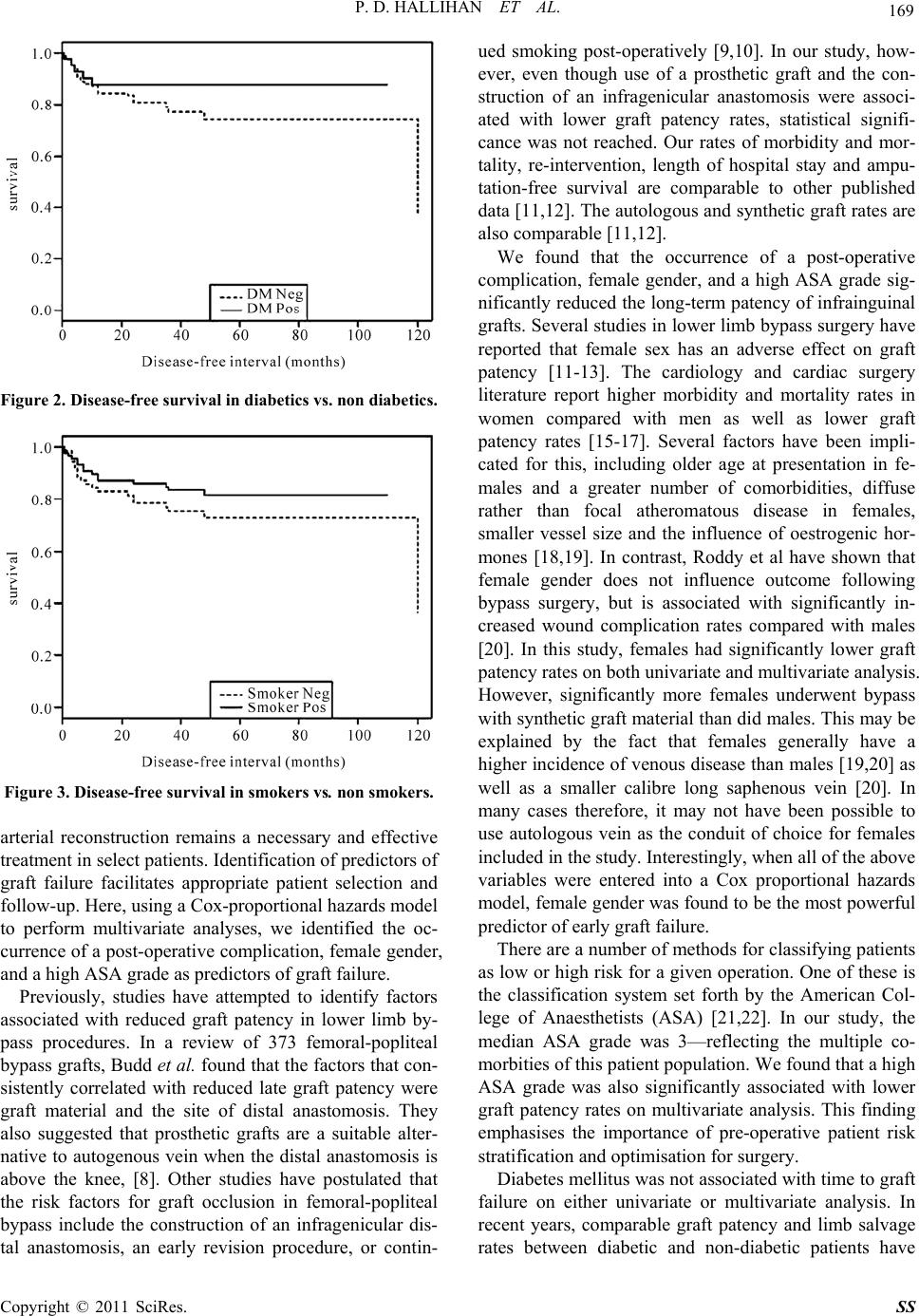 P. D. HALLIHAN ET AL. 169 Figure 2. Disease-free survival in diabetics vs. non diabetics. Figure 3. Disease-free survival in smokers vs. non smokers. arterial reconstruction remains a necessary and effective treatment in select patients. Identification of predictors of graft failure facilitates appropriate patient selection and follow-up. Here, using a Cox-proportional hazards model to perform multivariate analyses, we identified the oc- currence of a post-operative complication, female gender, and a high ASA grade as predictors of graft failure. Previously, studies have attempted to identify factors associated with reduced graft patency in lower limb by- pass procedures. In a review of 373 femoral-popliteal bypass grafts, Budd et al. found that the factors that con- sistently correlated with reduced late graft patency were graft material and the site of distal anastomosis. They also suggested that prosthetic grafts are a suitable alter- native to autogenous vein when the distal anastomosis is above the knee, [8]. Other studies have postulated that the risk factors for graft occlusion in femoral-popliteal bypass include the construction of an infragenicular dis- tal anastomosis, an early revision procedure, or contin- ued smoking post-operatively [9,10]. In our study, how- ever, even though use of a prosthetic graft and the con- struction of an infragenicular anastomosis were associ- ated with lower graft patency rates, statistical signifi- cance was not reached. Our rates of morbidity and mor- tality, re-intervention, length of hospital stay and ampu- tation-free survival are comparable to other published data [11,12]. The autologous and synthetic graft rates are also comparable [11,12]. We found that the occurrence of a post-operative complication, female gender, and a high ASA grade sig- nificantly reduced the long-term patency of infrainguinal grafts. Several studies in lower limb bypass surgery have reported that female sex has an adverse effect on graft patency [11-13]. The cardiology and cardiac surgery literature report higher morbidity and mortality rates in women compared with men as well as lower graft patency rates [15-17]. Several factors have been impli- cated for this, including older age at presentation in fe- males and a greater number of comorbidities, diffuse rather than focal atheromatous disease in females, smaller vessel size and the influence of oestrogenic hor- mones [18,19]. In contrast, Roddy et al have shown that female gender does not influence outcome following bypass surgery, but is associated with significantly in- creased wound complication rates compared with males [20]. In this study, females had significantly lower graft patency rates on both univariate and multivariate analysis. However, significantly more females underwent bypass with synthetic graft material than did males. This may be explained by the fact that females generally have a higher incidence of venous disease than males [19,20] as well as a smaller calibre long saphenous vein [20]. In many cases therefore, it may not have been possible to use autologous vein as the conduit of choice for females included in the study. Interestingly, when all of the above variables were entered into a Cox proportional hazards model, female gender was found to be the most powerful predictor of early graft failure. There are a number of methods for classifying patients as low or high risk for a given operation. One of these is the classification system set forth by the American Col- lege of Anaesthetists (ASA) [21,22]. In our study, the median ASA grade was 3—reflecting the multiple co- morbities of this patient population. We found that a high ASA grade was also significantly associated with lower graft patency rates on multivariate analysis. This finding emphasises the importance of pre-operative patient risk stratification and optimisation for surgery. Diabetes mellitus was not associated with time to graft failure on either univariate or multivariate analysis. In recent years, comparable graft patency and limb salvage rates between diabetic and non-diabetic patients have Copyright © 2011 SciRes. SS 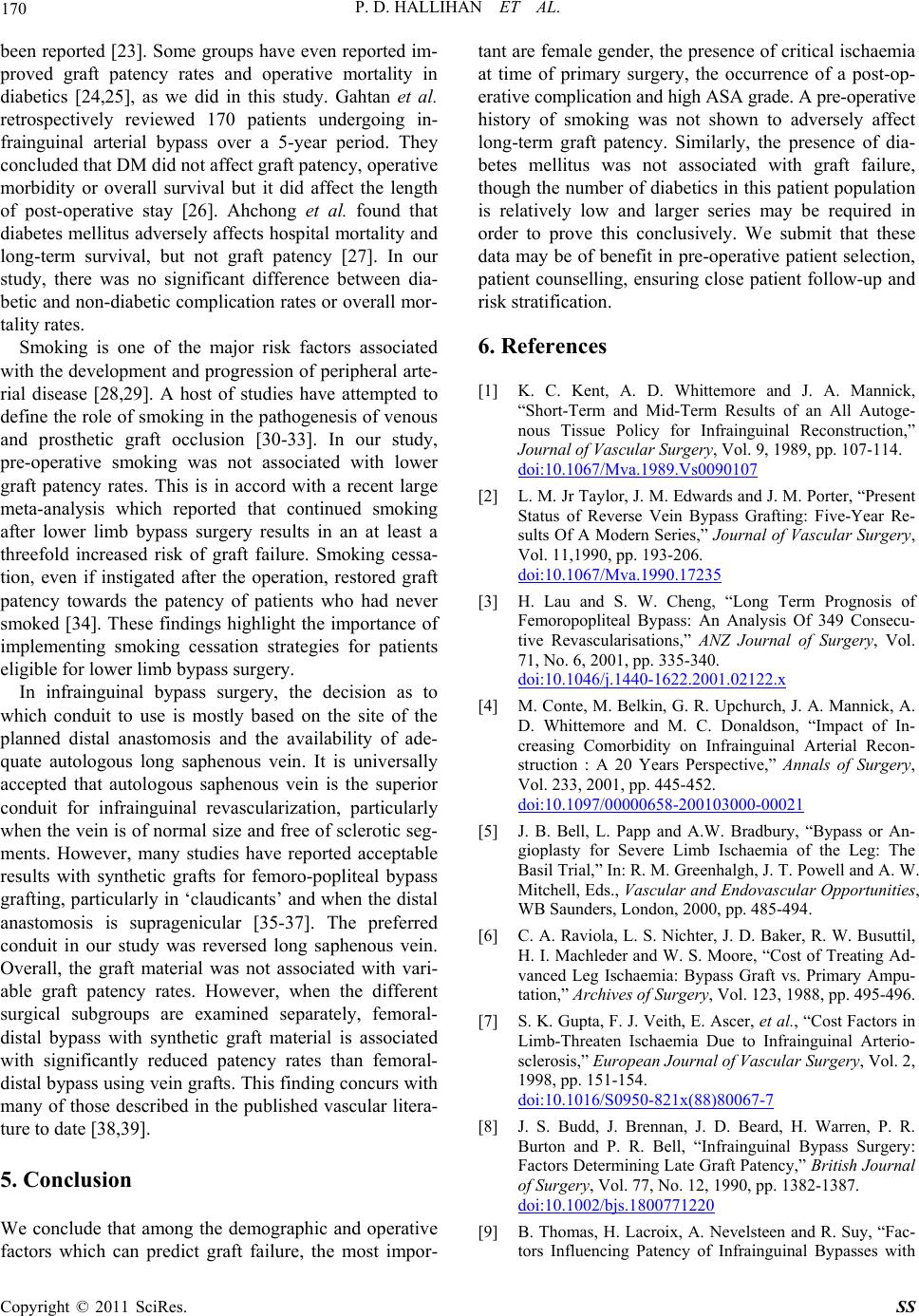 170 P. D. HALLIHAN ET AL. been reported [23]. Some groups have even reported im- proved graft patency rates and operative mortality in diabetics [24,25], as we did in this study. Gahtan et al. retrospectively reviewed 170 patients undergoing in- frainguinal arterial bypass over a 5-year period. They concluded that DM did not affect graft patency, operative morbidity or overall survival but it did affect the length of post-operative stay [26]. Ahchong et al. found that diabetes mellitus adversely affects hospital mortality and long-term survival, but not graft patency [27]. In our study, there was no significant difference between dia- betic and non-diabetic complication rates or overall mor- tality rates. Smoking is one of the major risk factors associated with the development and progression of peripheral arte- rial disease [28,29]. A host of studies have attempted to define the role of smoking in the pathogenesis of venous and prosthetic graft occlusion [30-33]. In our study, pre-operative smoking was not associated with lower graft patency rates. This is in accord with a recent large meta-analysis which reported that continued smoking after lower limb bypass surgery results in an at least a threefold increased risk of graft failure. Smoking cessa- tion, even if instigated after the operation, restored graft patency towards the patency of patients who had never smoked [34]. These findings highlight the importance of implementing smoking cessation strategies for patients eligible for lower limb bypass surgery. In infrainguinal bypass surgery, the decision as to which conduit to use is mostly based on the site of the planned distal anastomosis and the availability of ade- quate autologous long saphenous vein. It is universally accepted that autologous saphenous vein is the superior conduit for infrainguinal revascularization, particularly when the vein is of normal size and free of sclerotic seg- ments. However, many studies have reported acceptable results with synthetic grafts for femoro-popliteal bypass grafting, particularly in ‘claudicants’ and when the distal anastomosis is supragenicular [35-37]. The preferred conduit in our study was reversed long saphenous vein. Overall, the graft material was not associated with vari- able graft patency rates. However, when the different surgical subgroups are examined separately, femoral- distal bypass with synthetic graft material is associated with significantly reduced patency rates than femoral- distal bypass using vein grafts. This finding concurs with many of those described in the published vascular litera- ture to date [38,39]. 5. Conclusion We conclude that among the demographic and operative factors which can predict graft failure, the most impor- tant are female gender, the presence of critical ischaemia at time of primary surgery, the occurrence of a post-op- erative complication and high ASA grade. A pre-operative history of smoking was not shown to adversely affect long-term graft patency. Similarly, the presence of dia- betes mellitus was not associated with graft failure, though the number of diabetics in this patient population is relatively low and larger series may be required in order to prove this conclusively. We submit that these data may be of benefit in pre-operative patient selection, patient counselling, ensuring close patient follow-up and risk stratification. 6. References [1] K. C. Kent, A. D. Whittemore and J. A. Mannick, “Short-Term and Mid-Term Results of an All Autoge- nous Tissue Policy for Infrainguinal Reconstruction,” Journal of Vascular Surgery, Vol. 9, 1989, pp. 107-114. doi:10.1067/Mva.1989.Vs0090107 [2] L. M. Jr Taylor, J. M. Edwards and J. M. Porter, “Present Status of Reverse Vein Bypass Grafting: Five-Year Re- sults Of A Modern Series,” Journal of Vascular Surgery, Vol. 11,1990, pp. 193-206. doi:10.1067/Mva.1990.17235 [3] H. Lau and S. W. Cheng, “Long Term Prognosis of Femoropopliteal Bypass: An Analysis Of 349 Consecu- tive Revascularisations,” ANZ Journal of Surgery, Vol. 71, No. 6, 2001, pp. 335-340. doi:10.1046/j.1440-1622.2001.02122.x [4] M. Conte, M. Belkin, G. R. Upchurch, J. A. Mannick, A. D. Whittemore and M. C. Donaldson, “Impact of In- creasing Comorbidity on Infrainguinal Arterial Recon- struction : A 20 Years Perspective,” Annals of Surgery, Vol. 233, 2001, pp. 445-452. doi:10.1097/00000658-200103000-00021 [5] J. B. Bell, L. Papp and A.W. Bradbury, “Bypass or An- gioplasty for Severe Limb Ischaemia of the Leg: The Basil Trial,” In: R. M. Greenhalgh, J. T. Powell and A. W. Mitchell, Eds., Vascular and Endovascular Opportunities, WB Saunders, London, 2000, pp. 485-494. [6] C. A. Raviola, L. S. Nichter, J. D. Baker, R. W. Busuttil, H. I. Machleder and W. S. Moore, “Cost of Treating Ad- vanced Leg Ischaemia: Bypass Graft vs. Primary Ampu- tation,” Archives of Surgery, Vol. 123, 1988, pp. 495-496. [7] S. K. Gupta, F. J. Veith, E. Ascer, et al., “Cost Factors in Limb-Threaten Ischaemia Due to Infrainguinal Arterio- sclerosis,” European Journal of Vascular Surgery, Vol. 2, 1998, pp. 151-154. doi:10.1016/S0950-821x(88)80067-7 [8] J. S. Budd, J. Brennan, J. D. Beard, H. Warren, P. R. Burton and P. R. Bell, “Infrainguinal Bypass Surgery: Factors Determining Late Graft Patency,” British Journal of Surgery, Vol. 77, No. 12, 1990, pp. 1382-1387. doi:10.1002/bjs.1800771220 [9] B. Thomas, H. Lacroix, A. Nevelsteen and R. Suy, “Fac- tors Influencing Patency of Infrainguinal Bypasses with Copyright © 2011 SciRes. SS  P. D. HALLIHAN ET AL. 171 Polytetr afluoroethyle ne,” Acta Chirurgica Belgica, Vol. 99, No. 5, 1999, pp. 236-240. [10] J. P. Becquemin, F. Haiduc, J. Labastie and D. Melliere, “Femoropopliteal In Situ Saphenous Vein Bypass: Tech- nical Aspects And Factors Determining Patency,” Annals of Vascular Surgery, Vol. 1, No. 4, 1987, pp. 432-440. [11] J. G. Magnant, J. L. Cronenwett, D. B. Walsh, et al., “Surgical Treatment of Infrainguinal Arterial Occlusive Disease in Women,” Journal of Vascular Surgery, Vol. 17, No. 1, 1993, pp. 67-78. doi:10.1067/Mva.1993.42298 [12] M. A. Enzler, M. Ruoss, B. Seifert and M. Berger, “The Influence of Gender on the Outcome of Arterial Proce- dures in the Lower Extremity,” European Journal of Vascular and Endovascular Surgery, Vol. 11, No. 4, 1996, pp. 446-452. doi:10.1016/S1078-5884(96)80180-8 [13] M. Luther and M. Lepantalo, “Femorotibial Reconstruc- tions for Chronic Critical Leg Ischaemia: Influence On Outcome By Diabetes,” European Journal of Vascular and Endovascular Surgery, Vol. 13, No. 6, 1997, pp. 569-577. doi:10.1016/S1078-5884(97)80066-4 [14] J. I. Sawaya, C. Jazra, E. V. Eid and R. F. Sabra, “Gender Differences in the Diagnosis and Treatment of Acute Myocardial Infarction in Lebanon,” Le Journal Médical Libanais, Vol. 47, No. 1, 1999, pp. 2-6. [15] C. Maynard, P. E. Litwin, J. S. Martin and W. D. Weaver, “Gender Differences in the Treatment and Outcome of Acute Myocardial Infarction. Results from the Myocar- dial Infarction, Triage and Intervention Registry,” Ar- chives of Internal Medicine, Vol. 152, No. 5, 1992, pp. 972-976. doi:10.1001/Archinte.152.5.972 [16] F. D. Loop, L. R. Golding, J. P. Macmillan, D. M. Cosgrove, B. W. Lytleand and W. C. Sheldon, “Coronary Artery Surgery in Women Compared with Men: Analyses Of Risks And Long-Term Results,” Journal of American College of Cardiology, Vol. 1, No. 2, 1983, pp. 383-390. doi:10.1016/S0735-1097(83)80064-3 [17] E. S. Tan, J. Van Der Meer, P. Jan De Kam, P. H. Dunselman, B. J. Mulder, C. A. Ascoop, et al., “Worse Clinical Outcome but Similar Graft Patency in Women Versus Men One Year after Coronary Artery Bypass Graft Surgery Owing to an Excess of Exposed Risk Fac- tors in Women,” Journal of American College of Cardi- ology, Vol. 34, No. 6, 1999, pp. 1760-1768. doi:10.1016/S0735-1097(99)00404-0 [18] R. A. Raine, T. J. Crayford, K. L. Chan and J. B. Cham- bers, “Gender Differences in the Treatment of Patients With Acute Myocardial Ischemia and Infarction in Eng- land,” International Journal of Technology Assessment in Health Care, Vol. 15, No. 1, 1999, pp. 136-146. doi:10.1017/S0266462399152231 [19] M. J. Callam and C. V. Ruckley, “The Epidemiology of Chronic Venous Disease,” In: J. E. Tooke and G. D. O. Lowe, Eds., A Textbook of Vascular Medicine, Arnold, London, 1996, pp. 562-579. [20] J. L. Cronenwett and J. Magnant, “Gender Difference in Infrainguinal Outcome Arterial Occlusive Disease,” Cur- rent Critical Problems in Vascular Surgery, Vol. 6, 1994, pp. 30-37. [21] American Society of Anaesthesiologists (ASA), “New Classification of Physical Status,” Anaesthesiology, Vol. 24, 1963, p. 111. [22] G. Prause, B. Ratzenhofer-Comenda, G. Pierer, et al., “Can ASA Grade or Goldman’s Cardiac Risk Index Pre- dict Peri-Operative Mortality?,” Anaesthesia, Vol. 52, No. 3, 1997, pp. 203-206. doi:10.1111/J.1365-2044.1997.074-Az0074.X [23] S. Karacagil, B. Almgren, S. Bolwold, et al., “Compara- tive Analysis of Patency, Limb Salvage and Survival in Diabetic and Nondiabetic Patients Undergoing Infrain- guinal Bypass Surgery,” Diabetic Medicine, Vol. 12, No. 6, 1995, pp. 537-541. doi:10.1111/J.1464-5491.1995.Tb00537.X [24] C. M. Akbari, F. B. Pomposelli, G. W. Gibbons, et al., “Lower Extremity Revascularization in Diabetes: Late Observations,” Archives of Surgery, Vol. 135, 2000, pp. 452-456. doi:10.1001/Archsurg.135.4.452 [25] K. D. Wolfe, H. Bruijnen, H. Loeprecht, et al., “Graft Patency and Clinical Outcome of Femorodistal Arterial Reconstruction in Diabetic and Non-Diabetic Patients: Results Of A Multicentre Comparative Trial,” European Journal of Vascular and Endovascular Surgery, Vol. 25, No. 3, 2003, pp. 229-234. doi:10.1053/ejvs.2002.1849 [26] V. Gahtan, M. Harpavat, A. B. Roberts and M. D. Ker- stein, “Impact of Diabetes Mellitus on Infrainguinal By- pass Grafting,” Journal of Diabetes and its Complica- tions, Vol. 12, No. 4, 1998, pp. 197-200. doi:10.1016/s1056-8727(97)00111-6 [27] A. C. A. Kian, C. K. Ming; W. M. W. Chun, H. H. Kit and Y. A. W. Chun, “Diabetes and the Outcome of Infra- inguinal Bypass for Critical Limb Ischaemia,” ANZ Journal of Surgery, Vol. 74, No. 3, 2004, pp. 129-133. doi:10.1046/j.1445-2197.2004.02915.x [28] F. M. Ameli, M. Stein, R. J. Prosser, J. L. Provan and L. Aro, “Effects of Cigarette Smoking on Outcome of Femoral Popliteal Bypass for Limb Salvage,” Journal of Cardiovascular Surgery, Vol. 30, No. 4, 1989, pp. 591-596. [29] S. Wiseman, J. Powell, R. Greenhalgh, C. Mccollum, G. Kenchington, C. Alexander, et al., “The Influence of Smoking and Plasma Factors on Prosthetic Graft Patency,” European Journal of Vascular Surgery, Vol. 4, No. 1, 1990, pp. 57-61. doi:10.1016/S0950-821x(05)80039-8 [30] S. Wiseman, G. Kenchington, R. Dain, C. E. Marshall, C. N. Mccollum, R. M. Greenhalgh, et al., “Influence of Smoking and Plasma Factors on Patency of Femoropop- liteal Vein Grafts,” British Medical Journal, Vol. 299, No. 6700, 1989, pp. 643-646. doi:10.1136/Bmj.299.6700.643 [31] R. D. Sayers, M. M. Thompson, P. Dunlop, N. J. London, and P. R. Bell, “The Fate of Infrainguinal PTFE Grafts and an Analysis of Factors Affecting Outcome,” Euro- pean Journal of Vascular Surgery, Vol. 8, No. 5, 1994, pp. 607-610. doi:10.1016/s0950-821x(05)80599-7 [32] E. M. Willigendael, J. A. W. Teijink, M. -L. Bartelink, B. W. Kuiken, J. Boiten, F. L. Moll, et al., “The Influence of Smoking on the Incidence and Prevalence of Peripheral Copyright © 2011 SciRes. SS 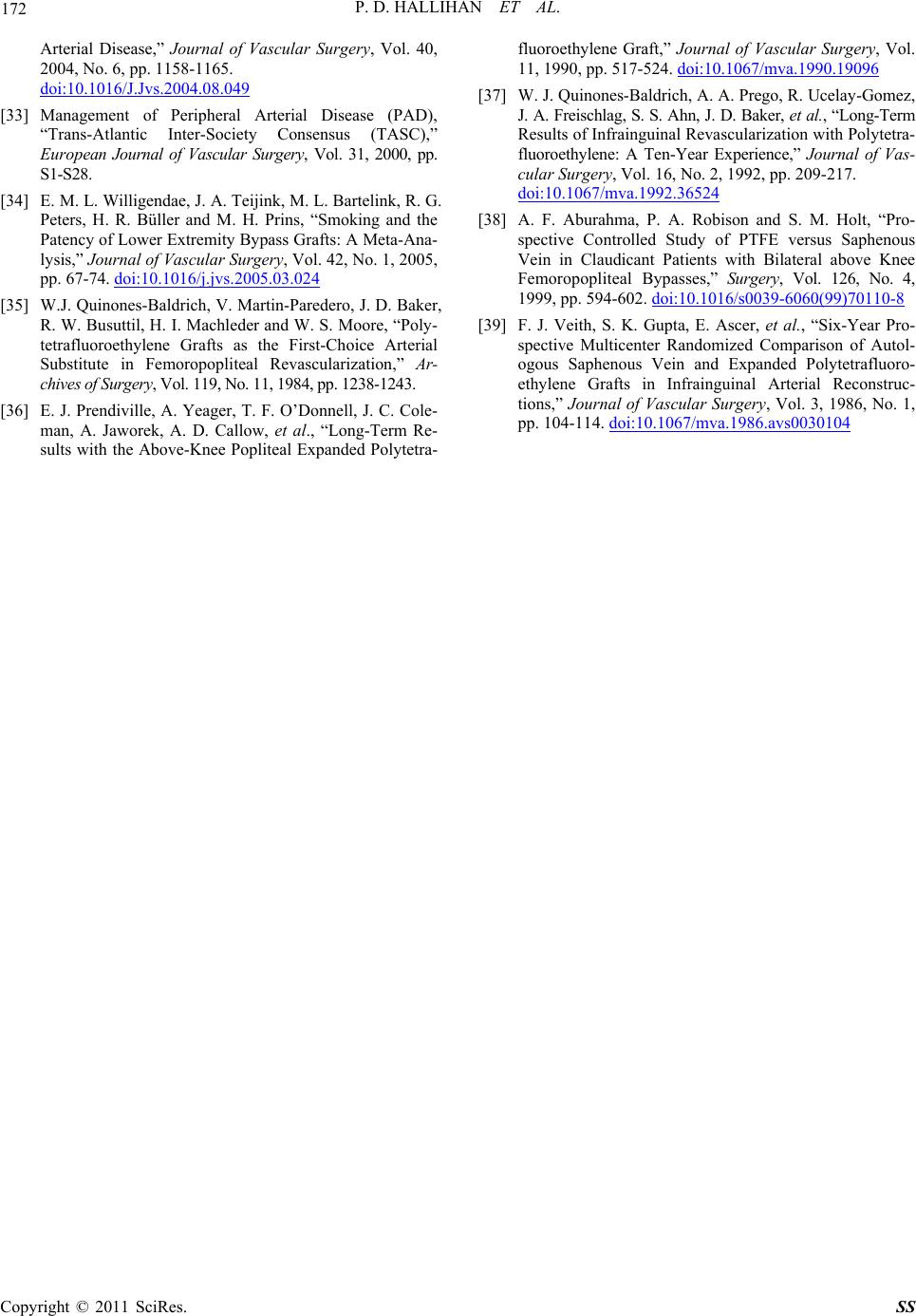 P. D. HALLIHAN ET AL. Copyright © 2011 SciRes. SS 172 Arterial Disease,” Journal of Vascular Surgery, Vol. 40, 2004, No. 6, pp. 1158-1165. doi:10.1016/J.Jvs.2004.08.049 [33] Management of Peripheral Arterial Disease (PAD), “Trans-Atlantic Inter-Society Consensus (TASC),” European Journal of Vascular Surgery, Vol. 31, 2000, pp. S1-S28. [34] E. M. L. Willigendae, J. A. Teijink, M. L. Bartelink, R. G. Peters, H. R. Büller and M. H. Prins, “Smoking and the Patency of Lower Extremity Bypass Grafts: A Meta-Ana- lysis,” Journal of Vascular Surgery, Vol. 42, No. 1, 2005, pp. 67-74. doi:10.1016/j.jvs.2005.03.024 [35] W.J. Quinones-Baldrich, V. Martin-Paredero, J. D. Baker, R. W. Busuttil, H. I. Machleder and W. S. Moore, “Poly- tetrafluoroethylene Grafts as the First-Choice Arterial Substitute in Femoropopliteal Revascularization,” Ar- chives of Sur ger y, Vol. 119, No. 11, 1984, pp. 1238-1243. [36] E. J. Prendiville, A. Yeager, T. F. O’Donnell, J. C. Cole- man, A. Jaworek, A. D. Callow, et al., “Long-Term Re- sults with the Above-Knee Popliteal Expanded Polytetra- fluoroethylene Graft,” Journal of Vascular Surgery, Vol. 11, 1990, pp. 517-524. doi:10.1067/mva.1990.19096 [37] W. J. Quinones-Baldrich, A. A. Prego, R. Ucelay-Gomez, J. A. Freischlag, S. S. Ahn, J. D. Baker, et al., “Long-Term Results of Infrainguinal Revascularization with Polytetra- fluoroethylene: A Ten-Year Experience,” Journal of Vas- cular Surgery, Vol. 16, No. 2, 1992, pp. 209-217. doi:10.1067/mva.1992.36524 [38] A. F. Aburahma, P. A. Robison and S. M. Holt, “Pro- spective Controlled Study of PTFE versus Saphenous Vein in Claudicant Patients with Bilateral above Knee Femoropopliteal Bypasses,” Surgery, Vol. 126, No. 4, 1999, pp. 594-602. doi:10.1016/s0039-6060(99)70110-8 [39] F. J. Veith, S. K. Gupta, E. Ascer, et al., “Six-Year Pro- spective Multicenter Randomized Comparison of Autol- ogous Saphenous Vein and Expanded Polytetrafluoro- ethylene Grafts in Infrainguinal Arterial Reconstruc- tions,” Journal of Vascular Surgery, Vol. 3, 1986, No. 1, pp. 104-114. doi:10.1067/mva.1986.avs0030104
|